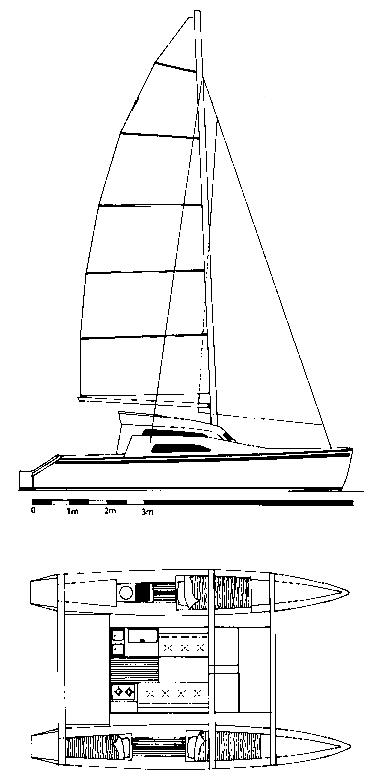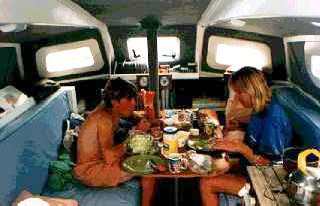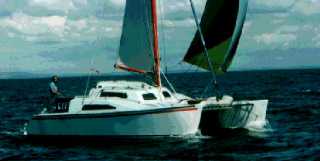Gypsy Boat Test
From-Multihull International, September 1998
By Tom Hammon
I'D READ THE BROCHURES, absorbed the blurbs and previously sailed in several designs from the Woods drawing board. Now it was time get afloat. I expected a fairly spartan, bucket and chuck it kind of craft, an overgrown Strider with a box on top and none of the luxury of her bigger sisters. I was sceptical of the cuddy concept and the liveaboard, ocean capability claims. Whilst I know that people do live and travel great distances in boats much smaller than the 28 foot Gypsy I sometimes doubt their sanity and hygiene standards! I hoped that the coming boat test would serve to dispel my concerns. Saltash Sailing Club sits almost beneath two of the Tamar's most famous bridges, one the modern road suspension bridge, the second, the solid, near ancient monument that Isembard Kingdom BruneI designed to carry the railway into Cornwall. Both are designed solely to carry land traffic over water and are great engineering feats of their time. The catamaran designer and builder is also a bridge builder who must unite two hulls, allow movement between them and attach one or more moving forces that can be comfortably and safely controlled and directed on the water. This also is no small engineering task.

Somehow it seemed appropriate to be collected from the Saltash Club's pontoon by Richard Woods in his latest Catamaran, the Gypsy 28. Now three years old Gypsy has steadily evolved and been completed whilst covering nearly 3,000 miles under Richard's experienced hand. I was on the pontoon early enough to watch Gypsy's approach from Millbrook and was struck immediately by her high sides and the unusual appearance of two hull cabins separated by another on the bridgedeck. The latter was the box or cuddy which I suspected would be cramped and airless. Beneath it the offset nacelle dipped down towards but well above the water. Designed as a liveaboard, long distance cruiser I wondered if Gypsy's engineering was as thorough as that of the bridges above. In spite of the high sides I had no difficulty in swinging a heavy bag onboard as I climbed onto the hull which brushed alongside the pontoon. Similarly embarkation would be easy from an inflatable. A boarding ladder is planned for swimmers who have to struggle onboard using the rudder housing. We set off downriver at a steady five knots courtesy of the very quiet l0 hp four-stroke outboard installed in the port aft corner of the cockpit. In order to improve quietness further, noise reducing material has been fitted to the outside of the engine cover and the inside of the deck box above. Gypsy's engine achieves l2 miles per gallon and enough fuel is carried for 100 miles. When under power and to assist manoeuvring the engine is linked to the tillers by simple tackles that are slackened when the engine is raised for sailing. This does much to counteract the engine's port offset bias.

I had boarded for'd and reached the cockpit via a narrow walkway between the hull cabins and the cuddy. It felt very safe as opposed to what is usually a scramble over all too often slippery cabin tops. No need for guardrails here they are built in! The next surprise came as I dumped my bag in the cuddy for this was not the expected cell but a roomy saloon galley combination with ample space for seven large adults to sit and for the cooker, fridge, large sink, 12 square feet of work surface and capacious stowage space. There was more besides including the switchboard, battery compartment, one water tank, a secret safe-space and, glory of glories, full standing headroom and all round visibility. The innovative, offset nacelle permits six footers to stand erect and is vee shaped underneath to discourage slamming. It is offset to starboard to provide cavernous stowage space behind the port settee. The forward slope of the cuddy provides yet more space partially taken up by a huge shelf for books, CDs etc. The table and settees convert easily to a spacious 6ft 6" x 4ft 6" double berth. Ventilation is as little or as much as required via opening hatches and the stable door entrance. I was beginning to see the sound sense behind Gypsy's somewhat chunky appearance. She is not pretty, not a sleek racy looking production line cruiser and no pocket racer but she does feel airy and light inside that capacious cuddy. Next move was to go down into the hulls.
I have spent enough time in cramped hulls that have kept me bent and bruised on long passages and expected little better from a boat that is after all not much longer than a Strider. Here the difference is enormous. Once down the easily negotiated steps I again found myself erect, all six foot of me! Gypsy's hulls each consist of three main compartments; forward and aft bunk spaces with stowage beneath and a real room between. In the port hull this is utilised as the bathroom and has room for an internal shower as well as the already fitted loo and large basin. To starboard the central space is used as the nav-centre where a chart table and stowage folds up to allow chartwork from a seated position. The separation of the cuddy from the two hulls thus provides room for privacy, all too often an impossibility in small boats. Whilst each for'd bunk could claim the honour of being a honeymoon double the smaller single bunks aft have plenty of room for comfort. This then is a boat which can easily accommodate six people for short cruises or for a couple to live aboard. In the latter case at least two of the bunk spaces would disappear, perhaps for his workshop and her larder!
Gypsy's build time (mostly in a 4.6m x 4.6m garage) was 980 hours by which time she was ready to sail though not complete. Richard feels that he has probably spent as much time fitting her out in the three years he has been sailing her since the launch. The build was achieved within the amazing budget of £5,000 which reflects his experience and skill, (and probably a come-in useful store built up over a lifetime of sailing!). Planning ahead he was able to get excellent fittings at ridiculous prices. One example is the rig (including roller-reefing) which except for the sails cost £200 and is likely to see the boat's life out! What it shows is that you can still build an excellent yacht remarkably cheaply given time, planning, effort and a little luck. About 20 sets of plans for Gypsy have now been sold and for the less experienced £10 - £15,000 seems a more realistic price bracket depending on building ability, finish and fittings.
On deck, simplicity is the rule to enable short-handed sailing or single-handing with a small auto-pilot. The fractional rig consists of a small jib and large fully battened main with almost all controls led back to the cockpit. Again layout is a matter of personal preference and more could be led aft. In Gypsy two small winches on the cabin roof and an Easimatic mainsheet are all that are needed to sail-trim and reef. They might be more effective if self-tailing and one or two more on the aft beam might ease spinnaker trimming. There are two winches on the mast but only because they came in the job lot. One winch is now used for the jib halyard but both would have been removed had Richard been able to free them. The various elements of the boat each have a function of their own but now was the time to discover how well they combine via the bridge and the sailing rig to become an entity,that multipurpose thing called a yacht.

I took over the helm just before the sails went up and found Gypsy light and responsive under power even with the offset engine. (Marina handling would be easier with two engines but the option is really a matter of preference, skill and confidence.) Pointing into the wind fairly approximately the main went up easily, courtesy of good and frequently greased slides and with no need of the winch. A cunningham, adjusted at the mast, tensioned the luff and that was that. The jib was unrolled, the engine lifted and we were in sailing mode beating towards Plymouth's eastern breakwater entrance at a healthy 5.5-6 knots in a SE force 3 wind. She could have gone faster. More tweaking string, new sails etc would doubtless do much to enhance Gypsy's performance hard on the wind. What did impress me was how close she was and for the cruising sailor that is important, i.e. When you have to do it do it efficiently and for as little time as possible. We were able to tack effortlessly through little more than 100 degrees and with enough forward power to avoid any indication of need to back the main.
Again light on the helm it was always easy to avoid the many boats in the Sound and once outside in a slightly freshening south easterly - and eight-eighths sun we fairly skipped along and easily parallelled a Moody 31. In the distance a similar size cat was rapidly dropping off to leeward. We aimed to sail close to compare speed and pointing but as she tacked to cross us the sail was promptly furled and she motored. As a cruising boat and for build simplicity Gypsy's flat panels form single chined, flat bottomed hulls aft with LAR keels midships. For'd the vee cross-section helps to prevent slamming. With the optional daggerboards and round, cedar-strip built bottoms the ride and performance would improve. The slight seas that we sailed into suggested that the hulls might slam a little in extreme conditions but with the for'd trampoline and high bridgedeck clearance there was no sign of spray reaching the undersides let alone a solid wave. The welcome sun and warmth notwithstanding I found helming a pleasure! The cockpit is spacious and sheltered. Two easily reached tiller extensions mean you can stand anywhere, lean against the cuddy or sit in the lee of the dodger. Last but not least you can sit up on the dodger rail. It is about 4" wide and remarkably comfortable and my coffee sat there unaided too ! Guardrails across the after part of the cockpit leave it fully enclosed and thus very safe. There is room for a wheel if that is preferred. The small jib, high angled boom and loose-footed sail all contribute to real all round visibility. Altogether and as all cruisers should, she gave a comfortable and steady ride ideal for the novice and/or more timid.

Had the wind freshened more we could have taken one to three reefs in the main and rolled the jib as necessary. The reefing lines were big, easily handled and led through top quality blocks back to the cockpit. No fancy boom fittings here, the blocks and lazy jacks ensure quick, safe reefing by one or two people. Gypsy is designed to carry full rig up to force 6 and to date the third reef has only been taken for practice.
Lunchtime saw us hove to in a briefly easing wind and slight residual swell. Very quiet and stable, we drifted slowly to leeward. There was time to reflect on what I'd seen so far. Putting myself back into building mode I was pleased that there were so many options in hull outline and interior layout. No dire threats of disaster for the slightest deviation from the plans. The builder is free to customise in the best sense of the word. My Gypsy would be slightly different from this; heads layout slightly altered, more creature comforts in the starboard hull................ It was perhaps as well that I was dragged from my dreams to start beating back to the eastern entrance.
Back inside the breakwater everything was in our favour, downwind on a flood tide. Moving onto a beam reach we hovered between 7 and 8 knots without effort in about 10 knots of wind. To be fair Gypsy was not loaded and in full cruising mode speeds are unlikely to be so good but there is no reason why trade wind sailing passages shouldn't approach 200 miles a day.
Those familiar with Plymouth will know that tides through the narrows can cause difficult eddies. Many yachts tend to motor upriver for fear of 'losing it' amongst the ferries and pleasure boats and the bevies of tugs and police escorts on the move each time a warship enters or leaves harbour. The zigzag route in further complicates the matter but we hoisted the spinnaker and enjoyed the trip and views. Her minimal draught, .7m, allowed us to stray outside the marked channel with impunity and away from the crowding keel and power boats. In the eddies she was easy to correct and the 'stretched' Strider spinnaker maintained plenty of steerage way whether running or reaching. In areas where the wind funnelled stronger we occasionally hit 10 knots and I wished for the force 6 and no reefs! A friend once water ski'd behind my ancient Val 31 and in suitable conditions he would also be able to behind Gypsy!
Gybing the spinnaker with ease we were soon close to Saltash again. The peace was only disturbed by an unsilenced workboat that struggled to overtake us and a speeding powerboat full of people that I can only imagine didn't know they were breaking a speed limit strongly enforced by the Queen's Harbourmaster. They can't have for they all waved as I photographed the evidence! We hovered beneath the twin bridges as Richard recovered the spinnaker and lowered the main. Almost as quickly I found myself back on the pontoon some 51/2, very good hours after leaving it.
Although I would have liked stronger winds for some of the test I was convinced already that Gypsy is a solid, safe yet remarkably nippy and budget conscious cruiser. Pretty she is not but she has an attractive purposeful look to her. She is an effective engineering solution to all the questions asked by any small boat that ventures out on the oceans and I'd be more than happy to go there with her.
Who knows? This is one dream at least that doesn't need a lottery win.









